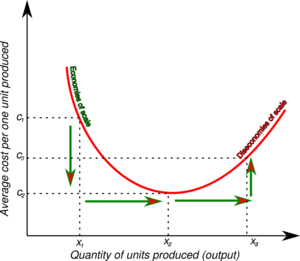Mass production
Mass production is the manufacture of large quantities of items based on the division of labour, high specialization and continuity (as opposed to make to order production). Product, in the course of the manufacturing process is constantly on the move, subjected to treatment or transported between manufacturing workstations. Workstation at all times perform work involving specific steps in production process. After the transfer of the item to the next workstation, next item should be taken into processing to preserve continuity of the work. Workstation are placed sequentially next to each other, so that the time allocated for the transfer of production items between them are minimal. Mass production is also characterized by a high repeatability of the manufacturing process.
Advantages of mass production
The main advantage of mass production is lower cost of production of one unit. This is due to the specialization of the work which also brings better quality of produced goods. Therefore, in the long run company can produce more products of better quality for a given sum of expenditures, which in turn decreases the cost of a single item produced.
Another advantage is the fact that the reproducibility of the work contributes to the achievement of better results. Continuously performing of the same tasks contribute to the improvement of the production processes and whole production system.
Disadvantages of mass production
Main disadvantages are narrow range of assortment of manufactured products. Goods produced in mass production system are characterized by very high similarity, because they come from the same production batch. This can cause low competitiveness of the company on the market.
Another disadvantage is the small flexibility of production. Highly specialized production line set for one type of item, must be substantially revamped in order to produce a different product, which increases unit cost of processing new product.
See also:
Examples of Mass production
- Automobile Manufacturing: Automobile manufacturing is a prime example of mass production. Automakers produce millions of cars each year, using robotic machines and automated assembly lines that are designed to be highly efficient. To produce the cars, automakers use a variety of specialized machines, such as presses to stamp out parts, robotic arms to assemble doors and frames, and paint booths to apply a finish.
- Electronics Manufacturing: Electronics manufacturing is another example of mass production. Companies such as Apple, Samsung and Sony produce millions of electronic devices each year, using automated assembly lines and robotic machines to achieve the highest level of efficiency. This includes the production of phones, tablets and other electronic devices, as well as the components that go into them.
- Food Processing: Food processing is another form of mass production. Companies such as Nestle and Kraft produce millions of food items each year, using automated machines and robotic systems to achieve high levels of efficiency. This includes the production of canned goods, frozen foods and other processed food items.
- Just in Time Production: Just in Time Production (JIT) is a manufacturing process that is used to reduce inventory and increase efficiency. This approach reduces the amount of inventory needed, minimizes lead times and reduces costs.
- Lean Production: Lean production is an approach to manufacturing that focuses on eliminating waste and increasing efficiency. It emphasizes on streamlining processes and using only what is needed to produce the desired product in the most efficient way.
- Agile Manufacturing: Agile manufacturing is an approach to manufacturing that emphasizes on responding quickly to customer needs. It focuses on flexibility, speed, and responsiveness in order to quickly adapt to changing customer needs.
- Automation: Automation is a process of automating certain tasks and processes in order to increase efficiency and reduce costs. Automation is used to reduce the amount of manual labor needed, increase accuracy and reduce costs.
In conclusion, various approaches related to mass production are Just in Time Production, Lean Production, Agile Manufacturing, and Automation. All of these approaches emphasize on streamlining processes, reducing costs, and increasing efficiency.
| Mass production — recommended articles |
| Serial production — Unitary production — Production line — Production rhythm — Group technology — Line production — Forms of production — Just in time — Job shop |
References
- Askin, R. G., & Standridge, C. R. (1993). Modeling and analysis of manufacturing systems. John Wiley & Sons Inc.
- Chase, R. B., Aquilano, N. J., & Jacobs, F. R. (1995). Production and operations management: manufacturing and services.
- Cochran, D. S., Arinez, J. F., Duda, J. W., & Linck, J. (2002). A decomposition approach for manufacturing system design. Journal of manufacturing systems, 20(6), 371-389.
- Gunasekaran, A., Martikainen, T., & Yli-Olli, P. (1993). Flexible manufacturing systems: An investigation for research and applications. European journal of operational research, 66(1), 1-26.
- Mass Production @ Wikipedia.
